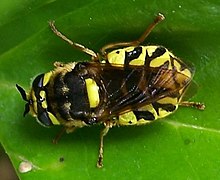Stratiomyoidea: Difference between revisions
Content deleted Content added
No edit summary |
Final Muscid (talk | contribs) Edited for readability |
||
| Line 16: | Line 16: | ||
'''Stratiomyoidea''' is a [[family (biology)|superfamily]] of [[fly|flies]] (order Diptera). |
'''Stratiomyoidea''' is a [[family (biology)|superfamily]] of [[fly|flies]] (order Diptera). |
||
The antennae have a primitive structure. A characteristic morphological characteristic of [[Pantophthalmidae]] |
The antennae have a primitive structure. A characteristic morphological characteristic of one family, [[Pantophthalmidae]], is the size of the body: this family includes some species that are among the largest Diptera, reaching wingspans of up to 10 cm. |
||
Stratiomyoidea larvae live in aquatic or terrestrial habitats and are mostly [[Scavenger|scavengers]] that feed on organic material. |
|||
{{Diptera|2}} |
{{Diptera|2}} |
||
Revision as of 03:07, 14 June 2022
| Stratiomyoidea | |
|---|---|

| |
| Stratiomys maculosa (Stratiomyidae) | |
| Scientific classification | |
| Domain: | Eukaryota |
| Kingdom: | Animalia |
| Phylum: | Arthropoda |
| Class: | Insecta |
| Order: | Diptera |
| Suborder: | Brachycera |
| Infraorder: | Stratiomyomorpha |
| Superfamily: | Stratiomyoidea Hendel, 1928 |
| Families | |
Stratiomyoidea is a superfamily of flies (order Diptera).
The antennae have a primitive structure. A characteristic morphological characteristic of one family, Pantophthalmidae, is the size of the body: this family includes some species that are among the largest Diptera, reaching wingspans of up to 10 cm.
Stratiomyoidea larvae live in aquatic or terrestrial habitats and are mostly scavengers that feed on organic material.
